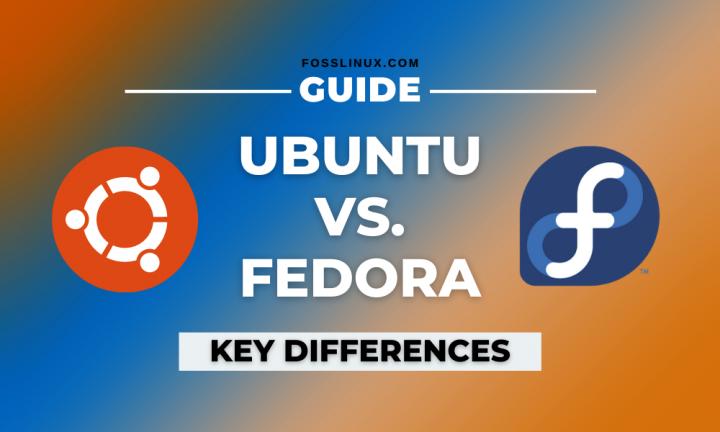Ubuntu vs. Fedora: The GNOME Experience Compared

GNOME is a popular desktop environment used in various Linux distributions, including Ubuntu and Fedora. Both distributions offer GNOME as their default desktop, but there are notable differences in their implementation.

Theme and Layout:

Ubuntu uses a custom GNOME theme called “Yaru,” which features bold colors, rounded window corners, and a modern aesthetic. Fedora, on the other hand, retains the default GNOME theme, which has a more traditional and minimalist look with sharp corners and neutral colors.
Applications and Extensions:
Ubuntu pre-installs a set of essential applications, including LibreOffice, Firefox, and Thunderbird. Fedora has a slightly broader selection of default applications, such as Rhythmbox for music and GIMP for image editing. Both distributions allow for the easy installation of additional applications and extensions through their respective package managers.
Customizations:
Ubuntu provides a user-friendly interface for customizing GNOME through the GNOME Control Center and GNOME Extensions. Fedora offers similar customization options but requires more manual configuration through terminal commands or third-party tools like dconf-editor.
Stability and Updates:
Ubuntu is known for its focus on stability and user-friendliness. It releases regular updates that prioritize bug fixes and security patches. Fedora, being more focused on new features and innovations, has a faster release cycle with more frequent updates that may occasionally introduce breaking changes.
Community Support:
Both Ubuntu and Fedora have active and supportive communities that provide helpful documentation, forums, and user groups. Ubuntu arguably has a larger community base due to its popularity, while Fedora’s community is more geared towards technical users and enthusiasts.
Conclusion:
The GNOME experience on Ubuntu and Fedora offers distinct strengths and trade-offs. Ubuntu provides a polished and user-friendly GNOME desktop with a focus on stability and convenience. Fedora offers a more customizable and feature-rich GNOME experience that prioritizes innovation and cutting-edge technology. The choice between the two depends on individual preferences, user experience priorities, and technical proficiency.## Ubuntu Vs. Fedora: The Gnome Experience Compared
Executive Summary
Ubuntu and Fedora are two of the most popular Linux distributions. Both distributions offer a GNOME desktop environment, but there are some key differences between the two. In this article, we will compare the GNOME experience on Ubuntu and Fedora and also list 5 subtopics.
Introduction
GNOME is a popular desktop environment for Linux distributions. It is known for its clean and user-friendly interface. Both Ubuntu and Fedora offer GNOME as their default desktop environment, but there are some key differences between the two.
Key Differences
1. Default Applications
- Ubuntu: Ubuntu comes with a wider range of default applications than Fedora. This includes applications such as LibreOffice, Firefox, and Thunderbird.
- Fedora: Fedora comes with a more minimal set of default applications. This includes applications such as GNOME Files, Firefox, and Evolution.
2. Software Repositories
- Ubuntu: Ubuntu has a larger software repository than Fedora. This means that there are more applications available for Ubuntu users.
- Fedora: Fedora has a smaller software repository than Ubuntu. However, Fedora’s software repository is more up-to-date.
3. Release Schedule
- Ubuntu: Ubuntu releases a new version every six months.
- Fedora: Fedora releases a new version every six months. However, Fedora also releases a new version of its GNOME desktop environment every six months.
4. Stability
- Ubuntu: Ubuntu is known for being a stable distribution. This means that it is less likely to experience crashes or other problems.
- Fedora: Fedora is known for being a more bleeding-edge distribution. This means that it is more likely to experience crashes or other problems.
5. Support
- Ubuntu: Both Ubuntu and Fedora has lively communities. This means that there is a lot of support available for both distributions.
Conclusion
Both Ubuntu and Fedora are great Linux distributions. The best distribution for you will depend on your individual needs. If you are looking for a stable distribution with a wide range of default applications, then Ubuntu is a good choice. If you are looking for a more up-to-date distribution with more bleeding-edge features, then Fedora is a good choice.
Keyword Phrase Tags
- Linux distributions
- GNOME desktop environment
- Ubuntu
- Fedora
- Software repositories

I’ve been using Ubuntu since 10.04 and trying Fedora since 10 version, so GNOME on Ubuntu is what i familiar with.
Both of them is rock!! 🙂
I’m a developer and Fedora `is` good for me.
Fedora is better bcause Ubuntu is used by mmy dad…
Well,GNOME in Fedora is more for experienced users right?
I have no idea `what` is this GNOME.
I totally agree with the blog, Ubuntu’s GNOME experience is really polished.
Sorry for my bad english, but i think Fedora GNOME not `easy` for new users.
I’m using KDE plasma, so i did’t care about this post haha.
Fedora is best linux distribution. 🙂